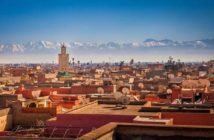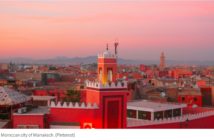It wasn’t quite the weather we had pictured as we stepped off the plane on our first trip to North Africa; lashing rain, strong winds and temperatures dropping to 13C.
As the taxi trundled up the twisty road to our first hotel in the High Atlas Mountains, biblical-looking characters in hooded robes or djellabas, sheltered in doorways and whole families on mopeds swerved the puddles. At one point the road turned into a river as thick, red mud gushed off the mountainside. A little further ahead, a section of the highway crumbled over the precipice. Travelling through Morocco is always an adventure, but we wondered if we’d even reach the hotel.
It was certainly a relief to arrive at the Ourika Garden Mountain Villa, 30 miles from Marrakech where the manager, Abdullah warmly welcomed us with our first glasses of steaming mint tea. We took refuge in our roomy suite, stuffed with antique Berber furniture, beautiful lanterns and colourful wall-hangings and the kids fought over the seat nearest the roaring open fire.
Thankfully the next morning, the skies were clear and we woke to the most incredible views of red and green mountains and snow-capped peaks.
Among the area’s most popular excursions are a trip to the six waterfalls at Setti Fatma or for the more adventurous, a hike in the High Atlas, which has peaks rising to 3,600m.
However, after the storm the night before, we decided it was safer to skip the falls and go on a tour of the Saffron gardens down in the valley. Abdullah drove us through small Berber villages clinging between the ragged cliffs and the roaring River Ourika. Eventually we wound up in the small market town of Takatert where large gates opened onto an oasis of tidy, green crops, fruit trees and fragrant shrubs with a backdrop of snowy peaks. After a tour of Le Jardin du Safran we were given mint tea on the sunny patio. The manager didn’t try too hard to sell his jars of saffron, just as well as they cost 350 dirhams (about £26) each. But we were happy to buy some essential oil.
The next stop was the gardens at Bayou Aromatic, which specialises in aromatic herbs and plants, such as rosemary, thyme, and lemon grass. The journey back took us through the busy back streets which were a hive of industry, row upon row of iron workshops, car mechanics, carpet sellers and butchers’ stalls with whole legs of lamb hanging on meat hooks outside.
The Ecomusee is in a Berber village half way up the Ourika valley. For 20dh (about £1.50) you can take a detailed tour of the old house, with a full explanation of the symbols in the carpets, (very basically, red for women, yellow for men). There are displays of wooden tools, mills and musical instruments plus a gallery of amazing black and white photos, including one of an elder standing barefoot in the snow.
The next day we left for Essaouira on the Atlantic coast, known as Morocco’s most popular resort. With its 18th-century battlements, pretty white-washed port and fine sandy beaches it draws crowds of families year round.
Essaouira is pretty breezy, which must be great in high summer, but can be a bit relentless for sun-bathing in the spring. Known locally as the alizee, the breeze is powering a growing water-sport industry, of wind and kite surfers.
It’s easy to escape the wind in the sheltered walls of the town’s medina, listed as a UNESCO World Heritage Site. The labyrinthine streets are packed with everything from pottery to paintings and curly-toed slippers to silver tea sets, plus a good few stalls selling spices piled into perfect pyramids. It feels a lot more laid-back than the medina in Marrakech, and you can take a good look before the inevitable bartering begins.
For some of the freshest sea-food in the country, head to the seafront grills opposite Place Moulay Hassan near the port. You’ll be accosted by waiters in white coats brandishing price lists, but just follow your nose. The fish, which is grilled in front of you, is priced by weight. For the four of us, we paid about £50 for a meal of lobster, king prawns, shrimps and large sea bass, with salad and bread, plus enough scraps for the sweet little cat under the table.
There are dozens of restaurants, cafes and patisseries in town, but by far the best meal in Essaouira was at Le Patio, a dark, cavernous restaurant in the heart of the medina, lit by hundreds of candles. We particularly enjoyed the tuna tagine and vegetables stuffed with minced meat.
There are some large hotels outside town, but for an authentic experience, we stayed at the Riad Chakir Mogador, a small bed and breakfast in the middle of the medina. Though the bathrooms are tiny, with unfeasibly thin doors, it makes up for this downstairs, with room after room of cushioned settees to lounge around in and relax.
Popular activities in Essaouira include quad biking and camel riding. We booked a three-hour camel trek through Ranch Diabat, located about five miles down the coast. The trek-leader, Mustaffa led our little group of five camels to the beach, across the dunes, through the Acacia trees and past an old fort, the Bordj el Berod, which was said to have inspired Jimi Hendrix’s Castles Made of Sand. Essaouira was indeed a favourite on the 1960s hippy trail, but Hendrix didn’t visit until two years after he’d already written the song. It doesn’t really matter though. In Morocco, it seems, it’s the legend that counts.
Getting there
Nicky Solloway organised her trip through Naturally Morocco (http://www.naturallymorocco.co.uk/) who booked all of the accommodation, transfers and the camel trek.
Several airlines fly direct to Morocco from Manchester, including TAP, Easyjet and British Airways. Jet2 have just started a limited number of flights to Marrakech from Leeds-Bradford.
Weather-wise, April and May are good months to visit, when temperatures on the coast average around 20C. Marrakech is usually much warmer.
The main languages are Arabic, Berber and French, though quite a few people speak English.






